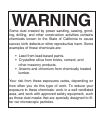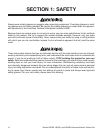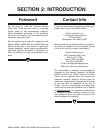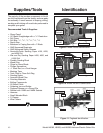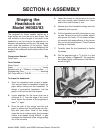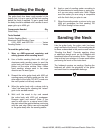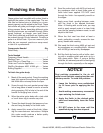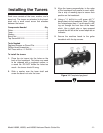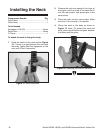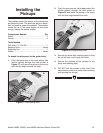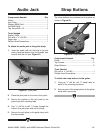
-8- Model H6082, H6083, and H6086 Heirloom Electric Guitar Kits
Like the guitar body, the guitar neck has been
rough sanded at the factory. Final sanding should
be done as described in the previous sub-section
"Sanding the Body". Consider applying inlays
or additional design work on the
fretboard and
headstock before final sanding. Note—Take your
time and test your designs in scrap wood before
performing the work on the instrument.
The fretboard requires no sanding. Sanding the
fretboard will affect the playability of the guitar
and could lead to unrepairable damage.
Sanding the Neck
6. Apply a coat of sanding sealer according to
the manufacturer's instructions or apply prim
-
er if you are using a solid color. Note—Make
sure the sealer you are using is compatible
with the fin
ish that you plan to use.
7. When the sanding sealer or primer is dry, use
#320 grit sandpaper for final sanding. DO
NOT sand through to bare wood.
The guitar body has been rough sanded at the
factory, but it is up to you to do the final sanding
before the finish is applied. To get a good finish
the body should be sanded with a series of sand
-
paper grits up to #320 grit.
Components Needed Qty
Guitar Body .......................................................
1
Tools Needed
Flexible Sanding Block .......................................1
Aluminum-Oxide Sanding Paper
#150, #220, and #320 Grit
............... Varies
Sanding Sealer .......................................... Varies
To sand the guitar body:
1. Wear an ANSI-approved respirator and
safety glasses when sanding wood!
2. Use a flexible sanding block with #150 grit
aluminum-oxide sanding paper to sand the
guitar body until there is a consistent scratch
pattern on the entire surface. Note—When
hand sanding, always sand in the same
direction as the wood grain.
3. Resand the entire guitar body with #220 grit
sanding paper and lightly round over the out
-
side edges of the body. DO NOT round over
the neck pocket or the body cavities.
4. Wipe the guitar body with a damp cloth to
“raise” the wood grain, allowing the “raised”
grain to be sanded smooth.
5. Wait until the wood is dry and resand
the entire body with #220 grit sandpaper.
Dampen again and resand. Note—If you
want to add color to a natural wood finish,
the stain should be applied before continuing
with the next step. Stains cannot be applied
to the guitar body after the sanding sealer.
Sanding the Body



